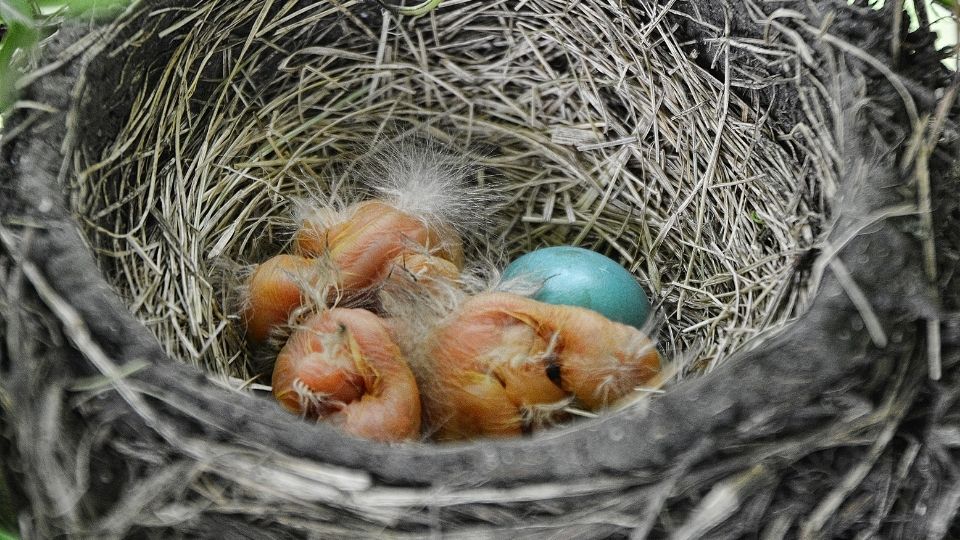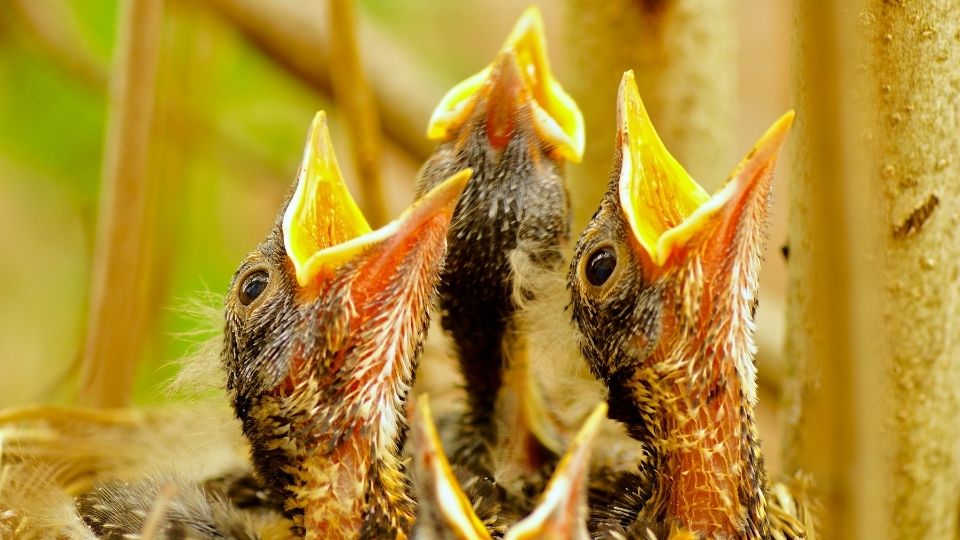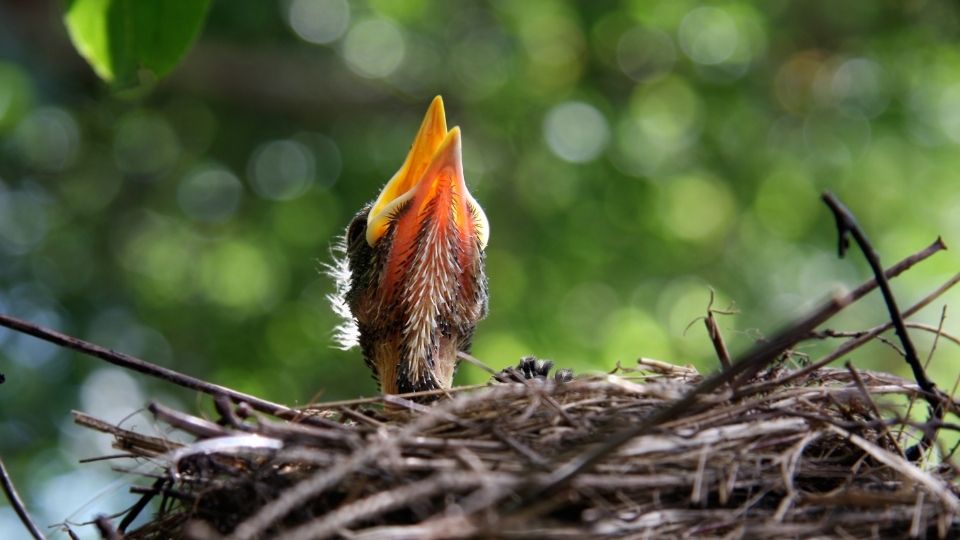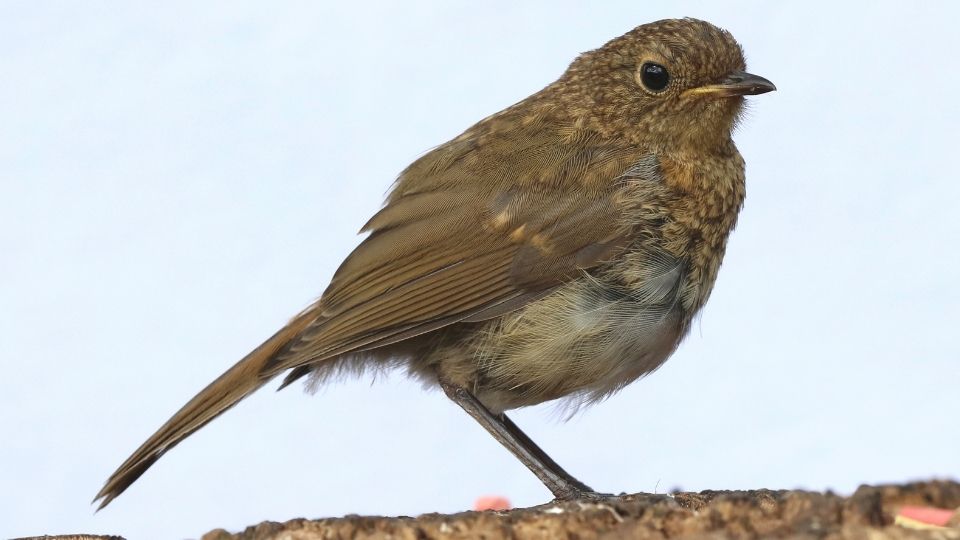Baby robins stay within the nest for the first four days and will survive on the regurgitated feeds and premasticated foods from their parent birds. The mother chews insects and fruits and feeds the baby birds small mouthfuls through her beak.
Baby Robins hatch from tiny fertilized blueish eggs of the Robin bird species. The baby birds take 12-14 days to hatch from fertilization. The parent birds, especially the female, firmly safeguard her eggs, sitting on them and rarely leaving the robin nests throughout the incubation period.
At the end of this incubating period, the baby hatchlings emerge from their eggs, and the mother supports the robin chicks from the nest. These nestlings are born altricial and depend on prenatal care and feeding for survival. Each chick has to fight to get its way out of the egg during the hatching process.
First, the robin hatchling breaks a hole with the hook on its beak. The little bird then pokes, stretches, and struggles inside the egg casing, stopping consequently to rest. This process continues until the bird breaks free.

What Do Baby Robins Eat?
The premasticated food helps facilitate easier passage through the hatchlings’ throats and provides critical nourishment during this period. This regurgitated food is soft and smoothly balanced to allow smooth passage of the material down the hatchlings’ digestive systems.
After six days, the birds will have developed an efficient digestive system that will allow more substantial food passage within the bird’s digestive tract. Hence, after six days, a hatchling can start to eat substantial amounts of food as required.
During this period, the baby birds, still considered hatchlings, will feed on earthworms, small insects, and other invertebrates like millipedes and centipedes that their parent bird has partially digested.
Parent Robin birds feed their young every three to four hours or so. If you have one in your care, you must attempt to feed the baby robin every half hour or so during the daylight hours.
A bird can go for long periods exceeding 20 hours without water; however, its parents feed it repeatedly to enable a sufficient amount of liquid within the hatchling’s body.
In the video below, we rounded up 10 little known facts about Robins!
What Do Baby Robins Do When They First Hatch?
Once Robin chicks hatch, they are totally dependent on their parent birds’ food and warmth. Adult robins often look after the nestlings.
Everyday, Robin parents can make up to 100 feeding visits to the nest. American Robins will nest in an area with a good food source nearby, so that the hatchlings are carefully watched.
Do Baby Robins Have Feathers When They Are Born?
The altricial nature of hatched Robins is notably due to the lack of feathers during birth. A brood patch covers the body of the hatched chicks. This bare patch of skin protects the bird’s inner body organs.
The patch is filled with blood vessels on the surface, allowing efficient warmth transfer from the parent to hatchlings. Feathers, however, start to grow within a 4-6 days period since hatching of the chicks.
Feather development is indicated by the appearance of quill-like features. At the age of three days, young Robins have the quills present at the underparts stretching backward. By five days, the little birds’ site is developed, and clear vision is obtained by the age of eight days.
This is when flanks and stretches of wings are strong enough to support independent flight, however, within proximity and distance from the parent robins nests.

Do Mother Robins Abandon Their Babies?
Mother Robins only abandon their babies when it is evident that the survival rates of the babies are lowered or minimal.
This is typical when the altricial development period is prolonged, or the bird notices a potential threat to a nest.
What Should You Do if a Baby Robin Is in a Nest?
The best and most eco-friendly measure of action to take after spotting a baby Robin is trying to move the nest and its nestling out of danger.
According to a wildlife rehabilitator, moving hatchlings away from the nest can lead to potential risks to the life and survival of the hatchling are noted. One can, however, provide the baby birds with bird feeders comprising of meals that baby Robins eat: mealworms, earthworms, or other grubs.
Hatchlings should be moved into a shaded area without affecting the meeting of the hatchling to its mother as the parent birds will most probably return. An individual who is not rightly aware of this process should seek assistance from animal protection companies.
What Is the Average Weight for a Baby Robin?
Newly hatched Robins weigh 6.6 grams. Baby Robin birds grow at very fast rates, with the birds reaching the parents’ body weight in two weeks.
The body of a mature male Robin bird is .23 ounces, and that of female parent ranges from 2.7 ounces to 3.0 ounces for males.

How Long Until They Start Flying?
The male bird’s primary duty is to train the hatchlings to obtain the capabilities of independent flight.
American Robin fledglings are born altricial; they must therefore build up muscle and strength through rigorous training jumping to and from branches. The birds possess this capability within 13 days after the fledging period.
The male birds fly at higher altitudes as the female hatches are comparatively reserved in performance and look. After the fledging period, when the birds can develop and maintain independent flights, they are allowed to lead independent lives as the mother prepares for another set of broods.

